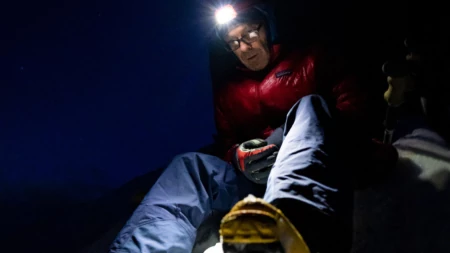Crash-Test Dummy
Who gets hypothermia on purpose? This guy.
The beauty of my plan was its simplicity: ski uphill in a soggy jacket, sit down in the snow and track the time until I got cold. Assuming the first trial went well, I’d ski back down, swap into dry underlayers, pull a second soaked parka from an insulated cooler and repeat the process. If one prototype kept me comfortable for longer while sitting in the snow at 10,000 feet after an hour of heat-generating work, I would have real-world proof that it dries faster and insulates better when wet. Two tests for the price of one. Genius.
And that is how I came to be dunking synthetic-insulation prototypes in my bathtub one February. Ideally, I figure, field testing should replicate worst-case scenarios because if it works for the severe, it should work for everything else. The goal of our synthetic insulation is to keep you warm in any conditions. The opposite of that is hypothermia. Hypothermia is dangerous because at a certain point, you slip over a fuzzy line and don’t realize you’re hypothermic. You stop shivering and might even feel warm and drowsy, wanting to sleep. Confusion is often an early sign.
A few minutes of daylight remained when I started the hour-long skin to my sitting spot. I’ve found that tests like these are best done at night since nobody else is out, which means no one to ask if you need help or why in the hell you’re wearing a wet jacket in winter. The wind blew steadily, punctuated by intermittent gusts. Soggy sure isn’t comfy, but field testing is all about making do. Besides, I ranted to myself, this is alpine, dammit, not sportswear. Sportswear testers never invite hypothermia.
Sometimes it takes a minute for my mind to settle. But I always love the peace of the backcountry in winter, and even the wind brings me calm.
My breath drifted and froze in the beam of my headlamp as I reached my spot, stomped out the snow and laid down my pack for a seat. But first I stood, staring at the stars and the galaxy, infinite and magnificent. I focused on my breath and tried not to think. Just be, notice. Then I noticed my mind drifting toward pondering the difference between chilly and deep-bone cold.
Now sitting on my pack, still staring into space, I remember a time, one of many, when I was up high on an alpine climb and began to shiver. It was back in my so-called “disaster style” days, when I was young and ambitious, and we were a mile above the glacier carrying only daypacks. We knew we couldn’t climb the mountain without a bivy, but had gone stupid-light anyway, infused with delusional optimism. We’ll deal with it when we have to deal with it. After twenty-some hours on the move, we dealt with it by burrowing into a snow mushroom to escape the wind, and there we huddled without sleeping bags, waiting for dawn. I remember willing myself to stop shivering because I wanted to conserve energy and deliberately slowing my breath as my temperature dropped. I am a monk in a cave, I told myself, trying to observe myself sinking into the cold while remaining conscious of that fuzzy line. I had set a mental alarm to ring when I got sleepy or goofy, before the tweety birds replaced the cognizant observer and I got too loopy to do isometrics. For hours I drifted along the line. I stared at the crystals of snow, with their intricate patterns, and began to consider relativity, like when you were a kid and wondered if the berry that you plucked from a tree could hold its own universe inside, one like ours but so tiny we couldn’t see it, and therefore, couldn’t we, too, be only the size of a berry to some other giant? As I listened to the wind and stared straight ahead, my thoughts brought me back to the snow. Have you ever sat in the dark and studied a tiny ridge of snow, whether formed by your hand or by the wind, and wondered if the sculpted ridges and valleys are really the view from an airplane, like when you fly into the Alaska Range, or if they’re a cornice before you when climbing a route? Or when you look into the night sky and remember the distance to the stars, and the moon, and the minuscule speck that is Jupiter, but recognize that it’s far from minute—we are minute but Jupiter is enormous, and so the ridges of snow could be either, depending on where we are.
Where am I?
A blob in the snow before me looks like ice cream. I like ice cream. I have some in my freezer at home, and it’s dark out here but not so cold; I think maybe I could take a nap. A gust of wind blasts me, tipping my torso slightly off balance. I blink, clear my head and look at my watch. Noted: benchmark time for jacket one. I bounce around and swing my arms. I do some isometrics, a few air squats, then dig into my pack for my dry parka, the backup I brought (because, safety first). By the time I ski down and grab the next jacket, I’ll be warm again, or at least not cold, but then maybe I’ll be cold again by the time I’m back here once more— watching my breath freeze while testing the second wet jacket and checking my watch to see how long it takes until I get cold. Quite simple, really. Jacket A versus jacket B. Me and the tweety birds, field testing beneath the stars.
This story was taken from the February 2020 edition of the Patagonia catalog.

